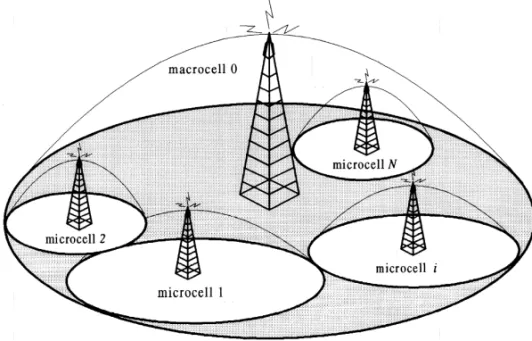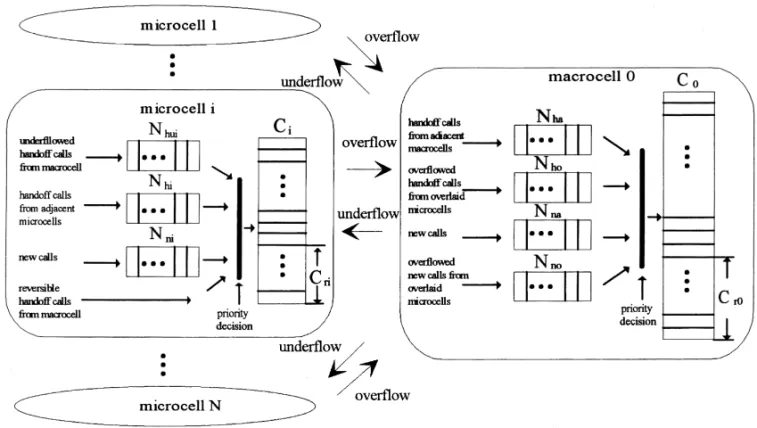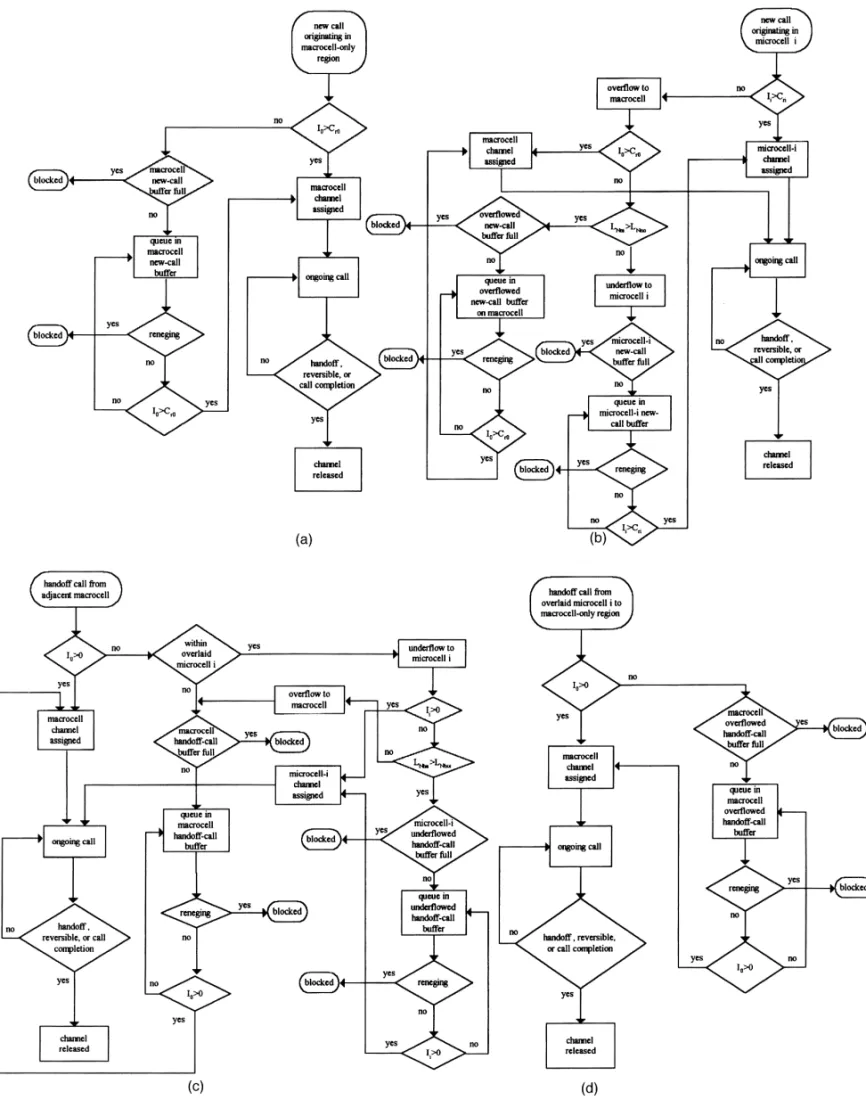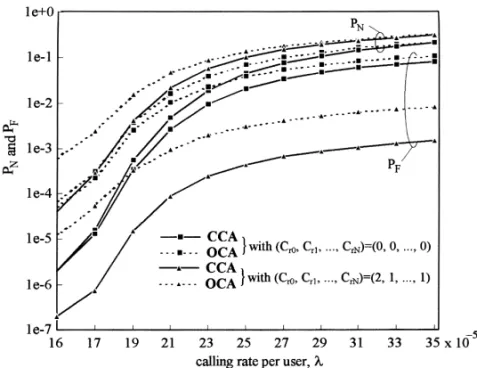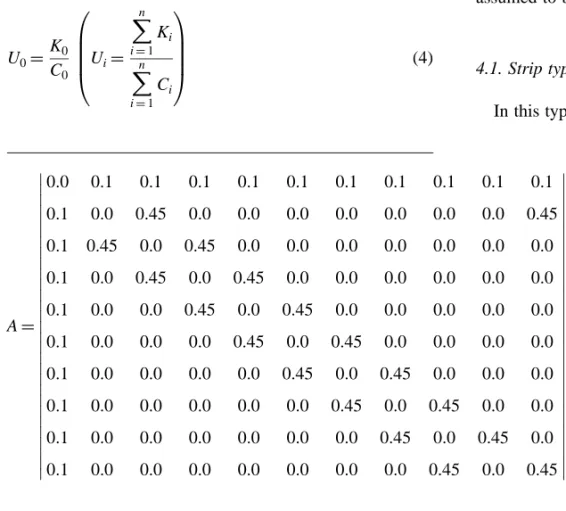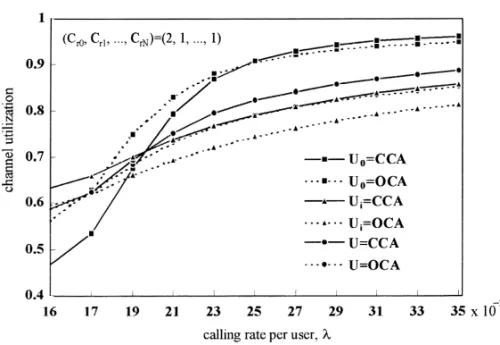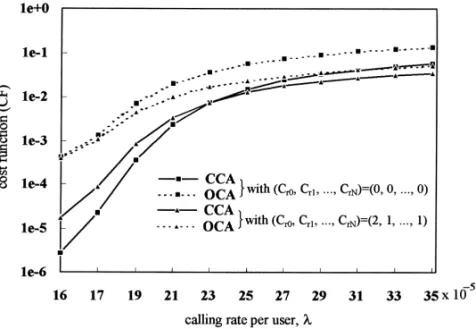A combined channel assignment mechanism for hierarchical cellular systems
>Kuen-Rong Lo
a , c, Chung-Ju Chang
b ,*, Cooper Chang
b, C. Bernard Shung
aaDepartment of Electronics Engineering, National Chiao Tung University, Hsinchu 300, Taiwan b
Department of Communication Engineering, National Chiao Tung University, Hsinchu 300, Taiwan
c
Network Planning Department, Telecommunications Laboratories, Chunghwa Telecom Co. Ltd, Taoyuan 326, Taiwan Received 13 February 1998; accepted 24 April 1998
Abstract
This paper proposes a combined channel assignment (CCA) mechanism for hierarchical cellular systems with overlaying macrocells and overlaid microcells. The proposed CCA mechanism combines overflow, underflow, and reversible schemes, where new or handoff calls having no available channel to use in the overlaid microcell can overflow to use free channels in the overlaying macrocell, handoff calls from a neighboring macrocell can underflow to use free channels in the overlaid microcell, and handoff attempts from a macrocell-only region to an overlaid microcell can be reversed to use free channels in the microcell. We apply the CCA mechanism in two different hierarchical cellular systems of Strip type and Manhattan type and compare the CCA with the overflow channel assignment (OCA) scheme. Simulation results show that the CCA mechanism outperforms the OCA scheme by once in forced termination probability, by several times in new call blocking probability, and by 4.7% in system utilization for a hierarchical cellular system, and the CCA mechanism is more suitable for the Manhattan type than for the Strip type.q 1998 Elsevier Science B.V.
Keywords: Hierarchical cellular system; Channel assignment; Overflow; Underflow; Reversible
1. Introduction
Due to the increasing demands for wireless communica-tion services, it seems essential to re-configure the existing cellular radio communication system into a hierarchical structure for enhancing the system capacity and improving the coverage. The hierarchical cellular system can provide overlaid microcells for high-teletraffic areas and overlaying macrocells for low-teletraffic regions [1–6].
In such a hierarchical cellular system, Rappaport and Hu proposed the overflow channel assignment (OCA) scheme that allows new and handoff calls which have no available channel in the overlaid microcell to overflow to use free channels in the overlaying macrocell [7,8]. The OCA scheme can reduce both the new-call blocking rate and the forced termination rate, and it is easy to implement because it needs no elaborate coordination between microcells. Beraldi et al. proposed a reversible hierarchical scheme [9], which allows the presence of handoff attempts from an overlaying macrocell to an overlaid microcell if there is any idle channel in the overlaid microcell. The reversible hierarchical scheme improves channel utilization in the
microcells and decreases the blocking rate of both new calls and handoff calls in the whole system since microcells are designed to be capable of supporting high capacity and balancing the traffic load.
However, these schemes could be insufficient in the situa-tion where there is a handoff call moving from an adjacent macrocell into an overlaid microcell of which the macrocell has no free channels but the overlaid microcell’s channels are not fully occupied, and the handoff call is dropped by the system. In this paper we consider an underflow scheme to allow such a handoff call to get a free channel in the micro-cell. The underflow scheme could decrease the handoff blocking rate or the forced termination rate.
Therefore, we propose a new channel assignment mechanism that combines overflow, underflow, and rever-sible techniques for the hierarchical cellular system in the paper. The combined channel assignment (CCA) mechan-ism also adopts a buffering scheme in order to obtain a high total admitted traffic while guaranteeing the grade-of-ser-vice requirements. It is a complete-partition buffering scheme where buffers in the macrocell are separately pro-vided for handoff calls from adjacent macrocells, over-flowed handoff calls from overlaid microcells, new calls originating in the macrocell-only region, and overflowed new calls from microcells. Buffers in each microcell are
0140-3664/98/$19.00q 1998 Elsevier Science B.V. All rights reserved PII S 0 1 4 0 - 3 6 6 4 ( 9 8 ) 0 0 1 7 7 - 7
* Corresponding author.
separately provided for underflow handoff calls from adjacent macrocells, handoff calls from adjacent microcells, and new calls originating in microcells. The scheme is not necessary to support a buffer for the reversible handoff call. Furthermore, the CCA mechanism assumes a priority ser-vice discipline in that the handoff call is given more priority than the new call and the inter-macrocell handoff is more important than the inter-microcell handoff.
The objective of the proposed CCA mechanism is to increase the channel utilization for the whole system by balancing the overall traffic load between macrocell and microcell. To balance load among cells is the most effective way to increase channel utilization. In the CCA scheme, the load balancing is performed by comparing the queue length in the overlaying macrocell with that in the overlaid micro-cell as a call request occurs and all channels are busy; if the queue length in the macrocell (microcell) is larger than the queue length in the microcell (macrocell), it denotes that traffic load in the macrocell (microcell) is heavier than that in the microcell (macrocell), and the call will be assigned to the microcell (macrocell).
Simulation results show that the CCA mechanism can outperform the OCA scheme by once in forced termination probability, by several times in new call blocking probabil-ity, and by 4.7% in system utilization. In the simulations, we also consider two types of hierarchical cellular systems: Strip type and Manhattan type. In the Strip type, the macro-cell overlaps many micromacro-cells which are put along highways like a strip. In the Manhattan type, the macrocell overlaps microcells which are put along city roads like Manhattan streets. It is found that the CCA scheme makes the traffic load more balanced in the Manhattan type than in the Strip type. This is because the Manhattan type has microcells that are better distributed than the Strip type.
The rest of the paper is organized as follows. In Section 2, the system model is described. The channel assignment strategy is presented in Section 3, and Section 4 gives the
definitions of the performance measures and shows simu-lation results and discussions. Concluding remarks are pre-sented in Section 5.
2. System model
The hierarchical cellular system contains a large geogra-phical region tessellated by macrocells, each of which over-lays several microcells. Fig. 1 depicts an architecture, where the overlaying macrocell is denoted by cell 0 and its over-laid microcells are denoted by cell 1,…,N. The coverage area of an overlaying macrocell is termed the macroarea. Within the macroarea, the area outside microcells is the region served only by the macrocell (cell 0). Hence, it is called the macrocell-only region. For cell i, 0# i # N, the system allocates a number of channels Ciof which Criare
used as guard channels for handoff calls. Increasing Cri
provides more protection for handoff calls but sacrifices the admission possibility of new calls.
We here propose a new channel assignment mechanism that combines overflow, underflow, and reversible schemes in the system. Details of the CCA mechanism will be described in the next section. The system also adopts a buffering scheme for new and handoff calls. As shown in Fig. 2, the system provides several buffers in the microcell i, among which a buffer with capacity Nhuiis for underflowed
handoff calls from the overlaying macrocell, a buffer with capacity Nhi is for handoff calls from adjacent microcells,
and a buffer with capacity Nniis for new call originations.
The system also supports buffers in the macrocell, among which a buffer with capacity Nhais for handoff calls from
adjacent macrocells, a buffer with capacity Nho for
over-flowed handoff calls from overlaid microcells, a buffer with capacity Nnais for new calls originating in the
macro-cell-only region, and a buffer with capacity Nn ois for
over-flowed new calls from overlaid microcells. Reneging of
Fig. 1. Hierarchical cellular system.
waiting new calls and dropping of waiting handoff calls are considered because of the impatience of new calls and hand-off calls moving out of the handhand-off area.
For convenience, the system is assumed to be homoge-neous, i.e. macrocells are statistically the same. Further assumptions are made in the following.
1. The new-call arrival process in a cell follows a Poisson process with calling rate per mobile station (user) l.
2. The handoff behavior of the user is characterized by a teletraffic flow matrix [7], defined as
A ¼ a00 a01 a02 … a0N a0d a10 a11 a12 … a1N a1d a20 a21 a22 … a2N a2d … … … … aN0 aN1 aN2 … aNN aNd
where ai j, iÞ j, represents the probability of a handoff call
originated in cell i and directed to cell j, 1# j # N, and ai d
denotes the probability of this handoff call directed to the adjacent macrocell. ai i would be zero and
X
;jaij¼1
for 0# i # N.
3. The dwell time of a mobile station in the cell i is assumed to have a negative exponential probability density func-tion 0# i # N [4,10]. Its mean depends on many factors such as cell radius, mobility, the path a mobile station follows, etc.
4. The unencumbered session duration of a call is a random variable having a negative exponential probability den-sity function.
5. The reneging (dropping) process for queued new (hand-off) calls is also assumed to be with a truncated expo-nential distribution.
6. The overflowed new-call arrival process to macrocell 0, the overflowed (underflowed) handoff call arrival pro-cess in the overlaying macrocell (overlaid microcell i), and the reversible handoff call arrival process from over-laying macrocell 0 to overlaid microcell i depend on the combined channel assignment mechanism.
3. CCA mechanism
The CCA mechanism for hierarchical cellular systems adopts an overflow scheme for blocked calls in microcells, a underflow scheme for blocked handoff calls in macrocells, and a reversible scheme, besides the guard channel protec-tion scheme for handoffs in each cell.
Fig. 3 shows the flowchart of the CCA mechanism. If a new call is originated in the macrocell-only region, as shown in Fig. 3(a), it will be immediately served by the macrocell (a macrocell channel is assigned) if the number of idle channels I0 in the macrocell 0 is larger than Cr 0;
otherwise, it will be put in the new-call buffer of the macro-cell. The new call will be blocked if the buffer is full. The queued new call may renege from the buffer unless it can be successfully served within its patience time. The assigned channel will be released if the ongoing call is terminated due to call completion, handoffs to a neighboring cell, or reverses to an overlaid microcell. If a new call is originated in the microcell i, as shown in Fig. 3(b), it will be immedi-ately served by microcell i (a microcell i channel is
Fig. 2. System model for the hierarchical cellular system. K.-R. Lo et al./Computer Communications 21 (1998) 1143–1152
Fig. 3. Combined channel assignment mechanism for (a) new calls originating in the macrocell-only region, (b) new calls originating in the microcell i, (c) handoff calls from adjacent macrocell, (d) handoff calls from microcell i to macrocell-only region, (e) handoff calls from microcell j to microcell i, and (f) reversible handoff.
assigned) if the number of free channels Iiis larger than Cri,
otherwise it will overflow to the overlaying macrocell. The overflowed new call will be immediately served by the macrocell if the number of idle channels I0in the macrocell
0 is larger than Cr 0; otherwise it will choose an overflowed
new-call buffer in macrocell or microcell i new-call buffer to queue according to their respective buffer length. The overflowed new call is underflowed to microcell i (kept in macrocell) and put in the new-call buffer (the overflowed new-call buffer) of microcell i (macrocell), if the length of the new-call queue LNni (the overflowed new-call queue
LNno) in microcell i (macrocell) is not larger (smaller) than
the overflowed new-call queue length in the macrocell LNno
(the new-call queue length in the microcell LNni). The call
will be blocked if both buffers are full. The queued new call may renege from the buffer unless it can be successfully served within its patience time. The assigned channel will be released if the ongoing call is terminated due to call completion, handoffs to a neighboring cell, or reverses to an overlaid microcell.
If the handoff call is from adjacent macrocells, as shown in Fig. 3(c), the call will be immediately served by the macrocell if there is any idle channel in the macrocell 0
(I0 . 0); otherwise, it will be put in the handoff-call
queue of macrocell 0 if the handoff call is not within over-laid microcell i, or be blocked due to a full buffer. If the handoff area is within the overlaid microcell i, the handoff call will underflow to microcell i and be immediately served by the microcell i if there is any idle channel in microcell i
(Ii. 0); otherwise, it will be put in the handoff buffer of
macrocell 0 or the underflowed handoff buffer of microcell i according to their respective queue length. The handoff call will be buffered in the underflowed handoff-call queue (handoff-call queue) of microcell i (macrocell 0) if there are no free channels available in both macrocell 0 and microcell i and the underflowed handoff-call queue length
LNhui (the handoff-call queue length LNha) in microcell i
(macrocell 0) is smaller (not larger) than the handoff-call queue length LNha (underflowed handoff-call queue length
LNhui) in macrocell 0 (micro cell i). The handoff call will be
blocked if both buffers are full.
If a handoff call is from microcell i to the macrocell-only region, as shown in Fig. 3(d), it will be immediately served if there is any idle channel in macrocell 0; otherwise it will be put in the overflowed handoff-call buffer of macrocell 0 if the buffer is available or be blocked if the buffer is full.
If the handoff call arrives at microcell i from adjacent microcell j, as shown in Fig. 3(e), it will be immediately served by microcell i if there is any idle channel in the microcell i; otherwise it will overflow to the overlaying macrocell. The overflowed handoff call will be immediately served by macrocell 0 if there is any idle channel in the macrocell 0; otherwise it will be put in handoff-call queue (overflowed handoff-call queue) of microcell i (macrocell) if the handoff-call queue length LNhi (overflowed
handoff-call queue length LNh0) in the microcell i (macrocell 0) is not
larger than the overflowed handoff-call queue length LNh0
(handoff-call queue length LNhi) in macrocell 0 (microcell i).
The call is blocked if both buffers are full.
All the queued handoff calls may be dropped by the
Fig. 3. (continued)
system as it moves out of the handoff area. The occupied channel is released if the call is terminated due to call completion, handoffs to a neighboring cell, or reverses to microcell.
Fig. 3(f) shows the flow chart of the CCA mechanism for the reversible handoff. For the handoff call from macrocell-only region to microcell i, the channel of the macrocell for this handoff call can be reversible to a channel in microcell i if there is an available channel in microcell i, otherwise the call will continue to use the channel of macrocell 0.
4. Simulation results and discussion
Four performance measures are considered: the new-call blocking probability, the forced termination probability, the cost function, and the channel utilization. The new call blocking probability, denoted by PN, is defined as the
average fraction of new calls, originating in the macrocell-only region or microcell i, that cannot be served by macrocell 0 or microcell i finally. It includes the reneging waiting calls that hand on the set before being served by the system. PNis
given by PN¼ Xn i ¼ 0 (BiþRi) Xn i ¼ 0 Ni (1)
where Bi(Ri) is the number of blocked (reneging) new calls
in cell i, and Ni(N0) is the number of new calls originating in
microcell i (macrocell-only region).
A forced termination occurs if a call is interrupted during its conversation time due to a handoff failure. The handoff failure means that the handoff call fails to gain a channel or is dropped out of the queue. The forced termination probability, denoted by PF, is the average fraction of Fig. 4. PNand PFfor CCA and OCA mechanisms in the Strip type.
Fig. 5. Cost function with a ¼ 0.1 for CCA and OCA mechanisms in the Strip type. 1148 K.-R. Lo et al./Computer Communications 21 (1998) 1143–1152
prematurely terminated calls, which is defined as the ratio of handoff failure to the total successfully initiated calls. PFis
given by PF¼ Xn i ¼ 0 (HiþHRi) Xn i ¼ 0 Si (2)
where Hi(HRi) is the number of blocked (dropped) handoff
calls in cell i, and Siis the number of successful new calls.
The cost function is defined as
CF ¼ aPNþ(1 ¹ a)PF (3)
where a is the weighting factor between PNand PF. It is an
overall blocking probability of the system.
The channel utilization of macrocells (microcells), denoted by U0(Ui), is given by U0¼K0 C0 Ui¼ Xn i ¼ 1 Ki Xn i ¼ 1 Ci 0 B B B @ 1 C C C A (4)
where K0(Ki) is the average number of busy channels in
macrocell 0 (microcell i) and C0(Ci) is the allocated
chan-nels for macrocell 0 (microcell i). We further define the channel utilization of the whole system, denoted by U, as
U ¼ K0þ Xn i ¼ 1 Ki C0þ Xn i ¼ 1 Ci (5)
where K0(Ki) and C0(Ci) are as defined above.
In the simulations, two types of microcell arrangement in
a hierarchical cellular system are investigated. The first type is a Strip type, in which N ¼ 9 microcells that are put in order along a highway like a strip. The second type is the Manhattan type, where N ¼ 9 microcells are constructed like Manhattan streets. A total of 150 channels are fixedly allocated to the macrocell and microcells with a pattern of (C0,C1,…,CN) ¼ (42,12,…,12) and (Cr0,Cr1,…,CrN) ¼
(2,1,…,1). The number of mobile stations in each cell is assumed to be 550. The mean unencumbered session dura-tion is 100 s. The mean dwell times in the macrocell and microcells are 225 and 150 s, respectively. The patience (dwell) time for queued new (handoff) calls is assumed to be in the range 5–20 s. Since the reneging (dropping) pro-cess is considered, it is not nepro-cessary to provide a large queue size for new (handoff) calls [11]. In these examples, all queue sizes in both the macrocell and microcells are assumed to be 1.
4.1. Strip type
In this type, the teletraffic matrix is assumed to be
Fig. 4 shows PNand PFversus new-call arrival rate per user
l for CCA and OCA mechanisms. We found that CCA can
have a significant improvement over OCA in both PN and PF for all call rates. Take a case of l ¼ 21 3 10¹5 and
(Cr 0,Cr 1,…,CrN) ¼ (2,1,…,1) for instance. The
improve-ment of PNfor the CCA mechanism over the OCA
mechan-ism is 2.2 times, and the improvement of PF is 11 times.
This is because the CCA mechanism combines overflow, underflow, and reversible schemes, and provides buffers for new and handoff calls. Fig. 5 shows the cost function CF with a ¼ 0.1 versus the calling rate l for the CCA and OCA mechanisms. We observe that CF of CCA is smaller
A ¼ 0:0 0:1 0:1 0:1 0:1 0:1 0:1 0:1 0:1 0:1 0:1 0:1 0:0 0:45 0:0 0:0 0:0 0:0 0:0 0:0 0:0 0:45 0:1 0:45 0:0 0:45 0:0 0:0 0:0 0:0 0:0 0:0 0:0 0:1 0:0 0:45 0:0 0:45 0:0 0:0 0:0 0:0 0:0 0:0 0:1 0:0 0:0 0:45 0:0 0:45 0:0 0:0 0:0 0:0 0:0 0:1 0:0 0:0 0:0 0:45 0:0 0:45 0:0 0:0 0:0 0:0 0:1 0:0 0:0 0:0 0:0 0:45 0:0 0:45 0:0 0:0 0:0 0:1 0:0 0:0 0:0 0:0 0:0 0:45 0:0 0:45 0:0 0:0 0:1 0:0 0:0 0:0 0:0 0:0 0:0 0:45 0:0 0:45 0:0 0:1 0:0 0:0 0:0 0:0 0:0 0:0 0:0 0:45 0:0 0:45 K.-R. Lo et al./Computer Communications 21 (1998) 1143–1152
than that of OCA. For the same case as above, CF of CCA is reduced 3.85 times under OCA. And the guard-channel protection scheme becomes more effective as the traffic load is increasing.
Fig. 6 shows channel utilization U, U0, and Uiversus the
calling rate per user l. The channel utilization U of CCA is superior to OCA. To take a range of l from 233 10¹5to 353 10¹5for instance, the channel utilization U of CCA is superior to OCA by 4%. This is because our scheme com-bines overflow, underflow, and reversible schemes, and pro-vides buffers for new and handoff calls. The channel utilization, U0 and Ui, of CCA is almost surrounded by
OCA in the heavy traffic, denoting the system traffic load is distributed in a more balanced manner in CCA than in OCA. This is because the microcells in the CCA mechanism with buffer provisioning absorb some traffic load from the overlaying macrocell; hence, Uiincreases at heavy traffic
load.
4.2. Manhattan type
The teletraffic matrix in this type is assumed to be
Fig. 7 shows PNand PFversus calling rate per user l for
the CCA and OCA mechanisms. We find that CCA can significantly improve PN and PFover OCA. For example,
when l ¼ 213 10¹5and ðCr0; Cr1;…; CrNÞ ¼ ð2; 1;…; 1Þ,
the CCA mechanism can improve 2.1 times in PNand 29.24
times in PFover OCA. Comparing the Manhattan type with
the Strip type, PFin the CCA mechanism for the Manhattan
type obtains more improvement than that for the Strip type. For example, at l ¼ 213 10¹5in the Manhattan type, the CCA with (Cr0,Cr 1,…,Cr N) ¼ (0,0,…,0) can improve by 11
times and the CCA with (Cr 0,Cr 1,…,CrN) ¼ (2,1,…,1) can
improve 29 times in PF over OCA, while in the Strip type,
the CCA with (Cr0,Cr 1,…,Cr N) ¼ (0,0,…,0) can improve
3.9 times and the CCA with (Cr0,Cr 1,…,Cr N) ¼ (2,1,…,1) A ¼ 0:0 0:1 0:1 0:1 0:1 0:1 0:1 0:1 0:1 0:1 0:1 0:1 0:0 0:3 0:0 0:3 0:0 0:0 0:0 0:0 0:0 0:3 0:1 0:2 0:0 0:2 0:0 0:2 0:0 0:0 0:0 0:0 0:3 0:1 0:0 0:3 0:0 0:0 0:0 0:3 0:0 0:0 0:0 0:3 0:1 0:2 0:0 0:0 0:0 0:2 0:0 0:2 0:0 0:0 0:3 0:0 0:0 0:25 0:0 0:25 0:0 0:25 0:0 0:25 0:0 0:0 0:1 0:0 0:0 0:2 0:0 0:2 0:0 0:0 0:0 0:2 0:3 0:1 0:0 0:0 0:0 0:3 0:0 0:0 0:0 0:3 0:0 0:3 0:1 0:0 0:0 0:0 0:0 0:2 0:0 0:2 0:0 0:2 0:3 0:1 0:0 0:0 0:0 0:0 0:0 0:3 0:0 0:3 0:0 0:3
Fig. 6. Channel utilization for CCA and OCA mechanisms in the Strip type. 1150 K.-R. Lo et al./Computer Communications 21 (1998) 1143–1152
Fig. 8. Cost function with a ¼ 0.1 for CCA and OCA mechanisms in the Manhattan type. Fig. 7. PNand PFfor CCA and OCA mechanisms in the Manhattan type.
Fig. 9. Channel utilization for CCA and OCA mechanisms in the Manhattan type. K.-R. Lo et al./Computer Communications 21 (1998) 1143–1152
can improve 11 times in PF over OCA. This is because
microcells in the Manhattan type are closer to adjacent macrocells than those in the Strip type; also, microcells are so well distributed in the Manhattan type. The successful handoff probability in the Manhattan type is larger than that in the Strip type. Thus, CCA is more suitable in the Manhattan type than in the Strip type.
Fig. 8 shows the cost function CF with a ¼ 0.1 versus the calling rate l. We observe that CF of CCA is smaller than that of OCA. In the example of l ¼ 21 3 10¹5, CF is reduced from 0.0198 for OCA to 0.00226 for CCA.
Fig. 9 shows channel utilization U, U0, and Ui versus the
calling rate l. The channel utilization U of CCA is superior to OCA. In examples of l from 233 10¹5to 353 10¹5, the channel utilization U of CCA is superior to OCA by 4.7%. This is because the CCA mechanism combines overflow, underflow, and reversible schemes, and provides buffers for new and handoff calls. Ui of the CCA mechanism is
higher than Uiof OCA. The reason is that microcells can
support traffic from the overlaying macrocell. U0of CCA is
higher than U0of OCA with heavy traffic; this is due to the
buffer effect. The CCA mechanism provides buffers to accommodate the calls which are not available channel to use in temporary, thus implying higher channel utilization. Again, Uiand U0of CCA are almost surrounded by those of
OCA, indicating the load balancing of CCA is better than that of OCA.
5. Concluding remarks
A combined channel assignment mechanism for a hier-archical cellular system is proposed in this paper. In this scheme the system not only provides overflow channels in an overlaying macrocell for new and handoff calls having no available channel to use in the overlaid microcell, but also allows handoff calls from a neighboring macrocell to underflow to use the free channel in the microcell. Mean-while, the handoff attempts from the overlaying macrocell to overlaid microcell can reverse to use free channels in the microcell if there are idle channels in the microcell. The simulation results show that the CCA mechanism can sig-nificantly decrease new call blocking probability and forced termination probability. Also it can achieve the balance of
load between macrocell and microcells, implying that the overall channel utilization is improved. We also investigate the two cases of Strip type and Manhattan type for the hierarchical cellular system, and it can be concluded that the CCA mechanism is more applicable in the Manhattan type than in the Strip type.
Acknowledgements
This work was supported by the National Science Council, Taiwan, under contract number NSC 85-2213-E009-006.
References
[1] V.R. Kolavennu, S.S. Rappaport, Traffic performance characterisation of a personal radiocommunication system, IEE pt. F 133 (1986) 550– 561.
[2] C.L.I., L.J. Greenstein, R.D. Gitlin, A microcell/macrocell cellular architecture for low- and high-mobility wireless users, IEEE J. Selected Areas Commun. 11 (1993) 885–891.
[3] L.P. Chin, J.F. Chang, Performance analysis of a hierarchical cellular mobile communication system, ICUPC 1993, pp. 128–132. [4] T.P. Chu, S.S. Rappaport, Overlapping coverage and channel
rearrangement in micro-cellular communication systems, IEE Proc. Commun. 142 (5) (1995) 323–332.
[5] G.L. Choudhury, S.S. Rappaport, Cellular communication schemes using generalized fixed channel assignment and collision type request channels, IEEE Trans. Veh. Technol. VT-31 (1982) 53–65. [6] S.S. Rappaport, Traffic performance of cellular communication
systems with heterogeneous call and platform types, ICUPC, 1993, pp. 690–695.
[7] S.S. Rappaport, L.R. Hu, Microcellular communication systems with hierarchical microcell overlays: traffic performance models and analysis, Proceedings of the IEEE 82 (9) (1994) 1383–1397. [8] S.S. Rappaport, L.R. Hu, Personal communication systems using
multiple hierarchical cellular overlays, IEEE J. Selected Areas in Commun. 13 (2) (1995) 406–415.
[9] R. Beraldi, S. Maramo, C. Mastroianni, A reversible architecture for microcellular systems with overlaying macrocells, Infocom ’96, 1996, pp. 51–58.
[10] S.S. Rappaport, Blocking, handoff and traffic performance for cellular communication systems with mixed platforms, Proc. Inst. Elec. Eng. 140 (I) (1993) 389–401.
[11] C.J. Chang, T.T. Su, Y.Y. Chiang, Analysis of a cutoff priority cellular radio system with finite queuing and reneging/dropping, IEEE/ACM Trans. Networking 2 (2) (1994) 166–175.
